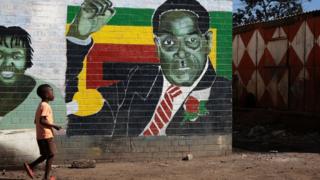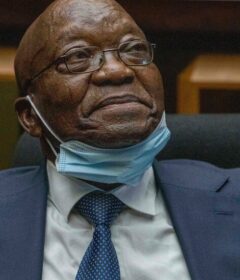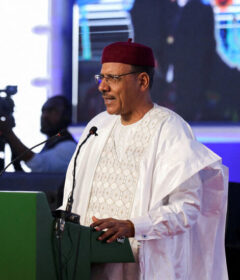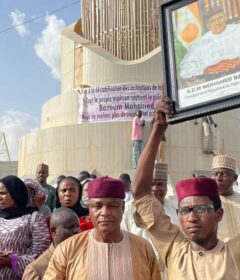Is Zimbabwe worse off now than under Mugabe?
Claim: Life in Zimbabwe is now worse than under former President Robert Mugabe, according to Fadzayi Mahere of the opposition Movement for Democratic Change (MDC).
Verdict: It’s true that in recent months, the economic situation has worsened. But there were periods during Mr Mugabe’s long rule when the economic indicators were much worse.
The opposition in Zimbabwe has called for protests over conditions in the country, accusing the government of economic mismanagement.
Since 2017, Zimbabwe has been led by President Emmerson Mnangagwa, following the overthrow of his long-serving predecessor Robert Mugabe by the military.
We’ve taken a look at some key national economic indicators as a measure of whether Zimbabweans are worse off today than they were before Mr Mnangagwa took over.
Zimbabwe's economic output
US$
The latest economic data suggests Zimbabwe’s economy has actually been shrinking over the past year as measured by gross domestic product (GDP) per capita, the average economic output per person.
This might be felt by Zimbabweans as a squeeze on jobs and wages as businesses struggle through difficult times.
But the projected figure for 2019 is only slightly lower than for 2017, Mugabe’s final year in office.
So although Zimbabweans may be feeling the effects of the recent decline, it’s not possible to argue from this data that the situation is significantly worse today than under the previous administration.
However, another important measure of the overall health of an economy is the level of investment by businesses.
This has fallen sharply since 2017. As a percentage of the value of the economy, it was nearly three times higher than the projected figure for 2019.
The government blames international sanctions, in place since 2002, for damaging the economy.
These sanctions target top officials and state-owned companies, and the US says they won’t be removed until meaningful political reforms take place.
Rising prices in Zimbabwe
When it comes to how ordinary Zimbabweans really feel about the economic situation, it’s price inflation that has more direct impact on their daily lives than overall growth or investment data.
At the end of 2017 when Mr Mugabe was removed from office, the annual rate of inflation – that’s the rate at which prices rise – was around 5%.
Inflation remained low until towards the end of 2018, but then rose sharply through the first half of 2019, reaching an annualised rate of 176% in June.
This is a measure of general consumer prices across the economy.
Professor Steve Hanke, an economics expert at Johns Hopkins University, who independently calculates rates of inflation, says it is considerably higher than official figures at 611% in August.
If this is narrowed down to just food prices, the picture looks even bleaker.
The annual food inflation figure released in June 2019 was measured at more than 250% according to the UN.
Food price inflation
So the cost of food on shop shelves has increased, fuel is in short supply and people’s pensions are now worth much less.
The UN’s World Food Programme (WFP) has appealed for funds for food aid, for what it calls the country’s “worst-ever hunger crisis”.
It says people in Zimbabwe have been severely affected by the impact of Cyclone Idai in March, droughts in some parts of the country and what it called “economic stagnation”.
The government has also reintroduced its own currency after a decade of relying on the US dollar.
This prompted an outcry from many workers, who would prefer to be paid in US dollars, and whose wages have shrunk in the past year because of inflation.
Has Zimbabwe seen worse?
Despite the current gloomy economic environment, there were periods under Mr Mugabe’s years in power that were far worse.
In 2007-09, the country went through a period of extreme hyperinflation that made the local currency worthless.
At one point in 2008, the annual inflation rate was over 500 billion percent according to the UN, and there was also high unemployment.
“In 2008, there was little food on the shelves. It was much worse on the ground than it is now,” says the BBC’s Shingai Nyoka in Harare.
There was widespread unrest and a government crackdown that saw large-scale killings and arrests by security forces.
“Mr Mugabe inherited a stable functioning economy that for the first 15 years of his rule he built on, creating a thriving black middle class,” says Ms Nyoka.
“But the last two decades of his rule ruined the economy. In its two years in office, the current government is still trying to resolve legacy issues from Mr Mugabe’s rule.”
What is the government saying?
Since the new government came into power it has undertaken a number of austerity measures – cutting spending, reducing some public sector wages and introducing new taxes – which it says are to get the economy back on track.
It has also said it is “open for business” after years of international isolation and high spending under Mr Mugabe.
It says the reforms are necessary to create an environment favourable for investors to create jobs.
But Zimbabwean economist Godfrey Kanyenze says the current government’s austerity policies have “spawned chronic high inflation and impoverished the majority of Zimbabweans”.
Read more from Reality Check
Send us your questions
Follow us on Twitter
Source: Read Full Article



